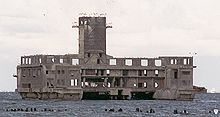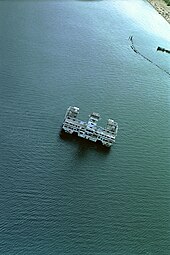Hexengrund (torpedo weapon area)
The Torpedowaffenplatz Hexengrund was a test facility for torpedoes of the German Air Force operated from 1942 to 1945 in the Danzig Bay near Gdynia (then Gotenhafen).
Facility
After the occupation of Poland in 1939 and the German attack on the Soviet Union , the Air Force built on the Putziger Wiek (part of the Gdańsk Bay ), north of the Gdingen district of Hexengrund (today: Babie Doły), where the Hexengrund Air Base and the Air Force ammunition plant were already located 3 / I found the "Torpedowaffenplatz Gotenhafen-Hexengrund". This was officially re-established as a branch on April 2, 1942. In terms of troops and discipline, he was subordinate to the Technical Office in the Reich Ministry of Aviation and thus to the " General Aircraft Master ". In the organization of the Wehrmacht the Hexengrund belonged to Luftgaukommando I in Königsberg . On May 1, 1944, the torpedo weapon area was placed under the command of the See Trial Center in Travemünde . He was responsible for the testing and improvement of air torpedoes and the associated launching devices, an area of military technology that had been largely neglected by the Wehrmacht .
use
The system consisted essentially of a U-shaped, four-storey building standing in the bay and with a reinforced concrete frame towered over by an observation and command tower in its center . The side wings were separated from the main part by two canals about six meters wide and seven meters deep. The building had two torpedo launch shafts 1.5 meters wide and four meters deep. A net was stretched between two smaller buildings in the bay, in which the shot torpedoes were recaptured. After completion of the facility, the torpedo research center moved from Warnemünde to Gotenhafen-Hexengrund.
The test torpedoes were mostly shot down or dropped in the direction of Heisternest . All new torpedoes for the German submarines that left Gotenhafen were also tested here before their final use, whereby they were equipped with an attachment head without an explosive charge. In order to test air torpedoes and sliding torpedoes such as the Blohm & Voss L 10 as well as the necessary launching and dropping devices on aircraft, various custom-made fighter aircraft or fighter-bomber Fw 190 were used, which were stationed at the nearby Hexengrund air base (Fw 190 A-5 / U14, Fw 190 A-5 / U15, Fw 190 F-8 / R14, Fw 190 F-8 / R15, Fw 190 F-8 / R16, Fw 190 F-8 / U2, Fw 190 (BT)).
The facility was used until almost the end of the war. In April 1945, the pier of the facility was used to transport refugees and wounded across the Baltic Sea to embark thousands of refugees from the east and wounded soldiers on German ships that brought them west. On the night of May 5, 1945, the speedboat escort ship Tsingtau and its speedboats evacuated 3,500 people from Hexengrund; the next morning the area was occupied by Soviet units.
Branch office
A branch existed in the Danish Aabenraa in North Schleswig .
Current condition
After the Second World War, a new torpedo facility ( Formoza ) was built about six kilometers further south near the naval port of Gdynia. The old facility, known in Poland as Torpedownia , is left to decay and its ruins with the remains of the pier piers still stand there today.
Coordinates: 54 ° 35 ′ 16 ″ N , 18 ° 32 ′ 44.6 ″ E
See also
Individual evidence
- ↑ http://www.deutsche-kriegsschiffe.de/Schiffe/schnellbootbegleitschiffe/tsingtau.htm
- ↑ http://www.avlg.dk/HostrupSkovTorpedostation.htm


